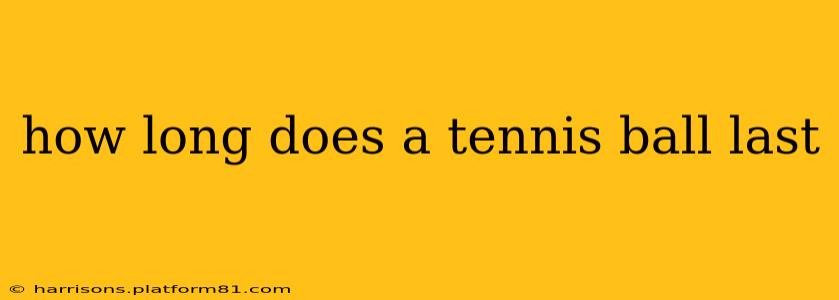Tennis balls, those fuzzy yellow spheres that propel the sport, aren't built to last forever. Their lifespan depends on several factors, making it difficult to give a single definitive answer. However, understanding these factors will help you determine when it's time to replace your tennis balls and maximize your game.
How Long Does a Tennis Ball Last During a Match?
This largely depends on the surface you're playing on. Hard courts are the most abrasive, significantly reducing the lifespan of a ball compared to clay courts. A single tennis ball used in a competitive match on hard court might only last a few games before becoming noticeably less bouncy and responsive. On clay, a ball might last a bit longer, though still likely only a set or two for professional-level play. Recreational play might extend this slightly.
How Long Does a Tennis Ball Last in Practice?
Practice sessions are typically less intense than matches, meaning a tennis ball can last a bit longer. However, consistent hitting can still wear down the felt quickly. Expect a tennis ball used in a practice session to remain usable for anywhere from a few hours to a full day, depending on the intensity and surface type.
How Long Does a New Tennis Ball Last Before Opening?
An unopened can of tennis balls can last for quite a while, typically up to two years under ideal storage conditions. Store your tennis balls in a cool, dry place away from direct sunlight and extreme temperatures. High heat and humidity are the biggest enemies of a tennis ball's longevity. Once opened, their lifespan dramatically decreases.
What Factors Affect the Lifespan of a Tennis Ball?
Several factors influence how long a tennis ball remains playable:
- Playing Surface: Hard courts are the toughest on tennis balls, causing them to lose pressure and bounce faster than on clay or grass.
- Intensity of Play: Frequent, hard hits will wear out a ball much quicker than gentle rallies.
- Environmental Conditions: Heat and humidity can accelerate the degradation of the felt and internal pressure.
- Storage: Proper storage (cool, dry place) significantly extends the shelf life of both opened and unopened cans.
- Type of Ball: Pressureless balls generally last longer than pressurized balls, but offer a slightly different playing experience.
How Can I Tell if My Tennis Ball is Worn Out?
Several signs indicate a tennis ball needs replacing:
- Poor Bounce: The most obvious sign. A worn ball will have a significantly lower bounce height than a new one.
- Flat Feel: The ball feels less responsive and "dead" when hit.
- Fuzzy Surface: The felt will become matted and worn, affecting its aerodynamic properties.
- Loss of Pressure (Pressurized Balls): Pressurized balls may lose their pressure, becoming softer and less bouncy.
What are the benefits of using new tennis balls?
Using new tennis balls offers several advantages:
- Consistent Bounce: Ensures a predictable and reliable bounce, crucial for consistent gameplay.
- Better Feel: Provides a better connection and response when hitting the ball.
- Improved Spin: New balls allow for better spin generation and control.
- Enhanced Gameplay: Overall, leads to a more enjoyable and competitive tennis experience.
By understanding these factors and recognizing the signs of wear, you can maximize the life of your tennis balls while maintaining the quality of your game. Remember, investing in quality balls and storing them properly will extend their lifespan and ultimately save you money in the long run.
